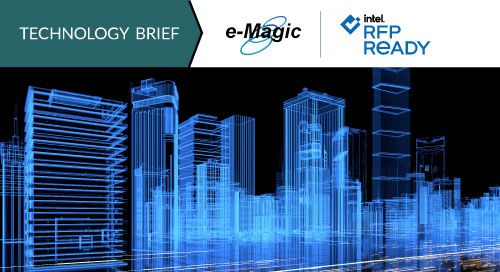Fill form to unlock content
Error - something went wrong!
Your content is just a step away. Please submit below.
Thank you!
Digital Twins Make Building Management Greener and Smarter

Companies with portfolios of assets in the built environment face a frustrating problem. They want their buildings—retail stores, factories, hospitals, or other structures—to be smart. After all, a smart facility consumes less energy, creates less waste, reduces maintenance costs, prolongs the life of assets, and delivers a host of additional operational efficiencies. But the data that businesses need to deliver such desirable outcomes is difficult to access, often locked behind proprietary protocols in separate legacy systems.
Fortunately, digital twins—functional models that represent physical assets and capture their interdependencies—can solve this problem. By unlocking and uniting data across systems, they give enterprises valuable operational insights, which building owners can use to make their facilities smarter, more sustainable, and easier to manage.
A Digital Twin Platform for Legacy Asset Management
“Organizations have a tremendous opportunity to leverage technology to make their businesses and their facilities smarter,” says Dale Kehler, Vice President of Business Development at e-Magic, a provider of digital twin solution TwinWorX®. Liberating asset-driven data from silos enables enterprises to make data-driven decisions instead of relying on unreliable parameters or gut intuition.
TwinWorX® does that by creating a digital model of physical assets and tracking their usage and interdependencies. As a result, enterprises can monitor and control their equipment through digital equivalents. TwinWorX® is also vendor-agnostic, aggregating live telemetry data from disparate assets onto a single platform. That means enterprises no longer have to work with 10 different software products for 10 different assets; they can simply view all relevant information through a single pane of glass.
Critically, digital-twin solutions like TwinWorX® capture the interdependencies among assets. By connecting thousands upon thousands of data points across systems, TwinWorX® enables asset managers to easily see how changing one variable would affect others. For example, dialing up the temperature setting in a building can reveal the effects it would have on the longevity of the furnace, carbon emissions, and energy costs. “Because there’s contextual data to support what you’re seeing, digital twins represent a new way of modeling data,” Kehler says.
Live telemetry data from assets doesn’t just flow one way. “By having bidirectional communication with the assets, you can actually control them from the digital twin,” Kehler says. The digital twin can change settings such as temperature, gas flow, or any other accessible parameter that enterprises want to manipulate.
With real-time data feeds, companies can receive notifications about operational anomalies that need immediate attention. And gathering all relevant data in one digital twin platform allows them to apply technologies such as machine learning and AI—not just to understand what’s happening now, but to foresee problems coming down the pike, and in some cases, apply predictive maintenance to prevent breakdowns.
Digital Twin Solutions Applications Range Across Industries
Digital twins have a wide array of applications depending on the setting, which can range from a single office tower to a sprawling manufacturing plant or medical complex.
TwinWorX® is most often used to centrally manage assets across multi-building environments, Kehler says. For example, Temple University wanted to create one centralized platform where it could view data from all building management systems across the campus. Because of the vendor-agnostic legacy asset management system TwinWorX® provides, the university now saves time by managing data in one place. It also saves money by avoiding redundant licensing and analytics tools.
#DigitalTwins have a wide array of applications depending on the setting, which can range from a single office tower to a sprawling #manufacturing plant or #medical complex. @eMagic02 via @insightdottech
Centralizing data and shaking off expensive vendor contracts, as Temple did, are early steps in the journey toward a smart environment, Kehler says. A digital-twin solution answers the question many building owners have: How can we architect our systems strategically and set ourselves up to manage a smart environment? With TwinWorX®, companies can start small, connecting a single asset or just a few, adding more as their goals become more ambitious.
Companies often start by seeking ways to lower energy bills and make their operations greener. “A lot of companies are dealing with rising energy costs and are addressing decarbonization efforts in order to meet sustainability commitments,” Kehler says. “Gaining visibility into how energy is used provides opportunities to find cost savings through reducing energy use and mixing energy composition.” Digital-twin solutions can show companies how using one kind of renewable energy—or a mix of renewable and traditional energy sources—will affect their overall sustainability profile.
The TwinWorX® platform runs on Intel® servers and processors, and e-Magic often recommends Intel® processors and IoT systems for customers’ edge computing implementations, which require low latency. e-Magic provides the digital-twin platform and connectivity tools for legacy asset management. Its systems integration partners provide additional advisory services for setting up specialized functions, such as carbon accounting.
The Future of Legacy Asset Management
While it’s still early days for digital twins, Kehler expects adoption to ramp up in the near future, especially for companies addressing sustainability goals, as legislation forces building owners to realize energy efficiencies quickly.
As implementations increase, digital twins may someday help to create entire ecosystems of interconnected systems, with built environments and smart cities working synchronously toward a common set of efficiency goals.
This article was edited by Teresa Meek, Contributor for insight.tech.